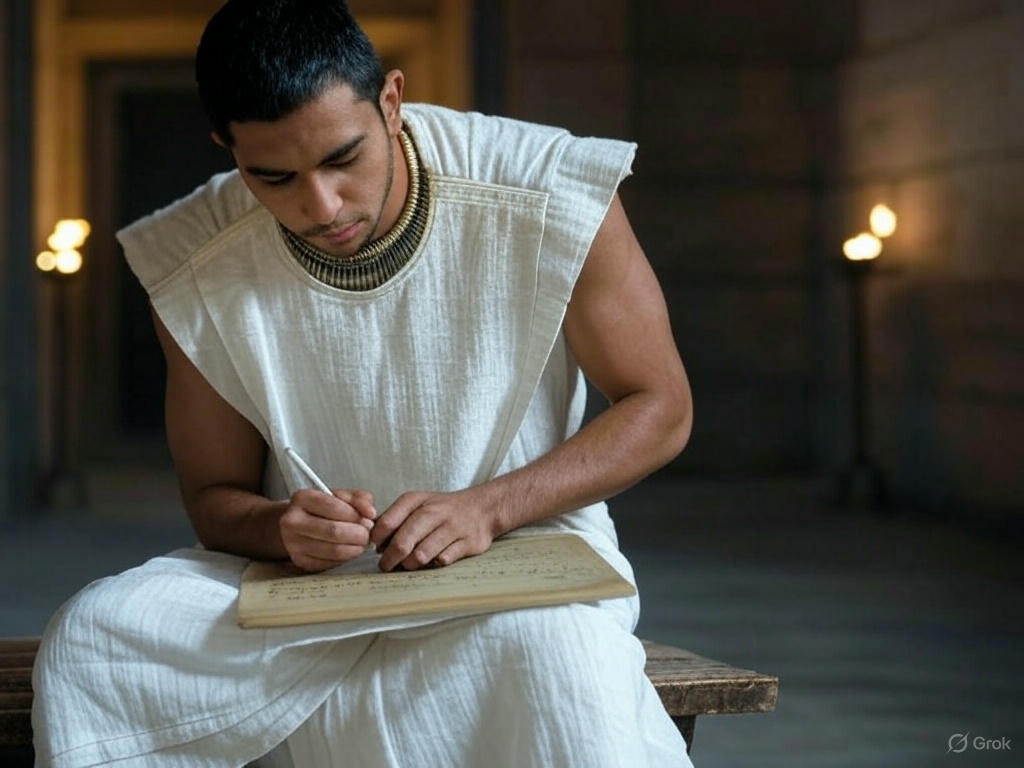Picture the colossal pyramids of Giza, standing in perfect geometric harmony against the desert horizon. How did the ancient Egyptians achieve such architectural precision over 4,500 years ago without modern calculators or computers? The answer lies in their sophisticated mathematical system—one that solved complex problems with elegant simplicity and laid the groundwork for mathematical concepts we still use today.
As a historian specializing in ancient mathematical systems, I’ve spent years studying the remarkable problem-solving techniques preserved in Egyptian papyri. What continually amazes me is how their practical approach to mathematics—developed primarily to address real-world challenges in construction, agriculture, and administration—achieved such accuracy through methods entirely different from our own.
In this comprehensive exploration, you’ll discover the ingenious numerical system that powered one of history’s greatest civilizations, from their unique approach to fractions to the geometric principles that enabled their monumental architecture. Whether you’re a mathematics enthusiast, history buff, or simply curious about how ancient innovations continue to influence our modern world, prepare to gain a new appreciation for the mathematical legacy of ancient Egypt.
Table of Contents
- The Egyptian Numerical System: Elegant Hieroglyphics
- Calculation Methods: Addition, Multiplication, and Division
- The Revolutionary Egyptian Fraction System
- Mathematical Papyri: Ancient Problem-Solving Textbooks
- Geometry and Measurement in the Land of the Pharaohs
- Practical Applications: Architecture, Agriculture, and Administration
- The Legacy of Egyptian Mathematics
- How to Appreciate Egyptian Mathematics in Modern Life
- FAQs About Ancient Egyptian Mathematics
The Egyptian Numerical System: Elegant Hieroglyphics
Decimal But Not Positional
The ancient Egyptians developed a base-10 decimal system as early as 3000 BCE, likely because humans have ten fingers. Unlike our modern system, however, theirs was not positional—each symbol had a fixed value regardless of its position in a number.
Their numerical hieroglyphics included:
- A vertical stroke (|) for 1
- A heel bone (⌒) for 10
- A coiled rope (Ꝏ) for 100
- A lotus flower (⧓) for 1,000
- A pointing finger for 10,000
- A tadpole for 100,000
- An astonished man for 1,000,000
To write numbers, they simply repeated symbols as needed. For example, 365 would be written as three “hundred” symbols, six “ten” symbols, and five “one” symbols: ꝎꝎꝎ⌒⌒⌒⌒⌒⌒|||||.
The Additive Principle
This system functioned on an additive principle—you simply count the value of all symbols to determine the number. While visually intuitive, it had limitations for complex calculations because it required writing multiple repetitive symbols for larger numbers.
What I find most fascinating is that despite these limitations, Egyptian scribes developed clever computational methods that compensated for the system’s constraints. This demonstrates a principle we see throughout mathematical history: when faced with notational limitations, human ingenuity finds alternative pathways to solve problems.
Calculation Methods: Addition, Multiplication, and Division
Addition and Subtraction: Straightforward Combining
Addition in the Egyptian system was relatively straightforward—scribes would combine like symbols and convert groups of ten symbols into their higher-value equivalents. For instance, ten “one” strokes would be converted to one “ten” heel bone.
Subtraction followed a similar process in reverse, breaking down higher-value symbols when needed. Though conceptually simple, these operations required careful record-keeping when working with large numbers.
Multiplication: The Doubling Method
Egyptian multiplication reveals their mathematical ingenuity. Rather than memorizing multiplication tables, they used a doubling method that reduced multiplication to a series of additions and doublings—operations that humans can perform intuitively.
Here’s how it worked for calculating 13 × 14:
- Start with two columns, placing 1 and 14 at the top
- Double both values repeatedly:
- 1 → 14
- 2 → 28
- 4 → 56
- 8 → 112
- Identify which powers of 2 on the left sum to the multiplier (13 = 1 + 4 + 8)
- Add the corresponding values on the right (14 + 56 + 112 = 182)
The answer: 13 × 14 = 182
This method, while seemingly roundabout to modern eyes, is computationally efficient and requires memorizing almost nothing. I’ve tested this method with students, who often grasp it more intuitively than traditional multiplication tables—a testament to its clever design.
Division: Multiplication in Reverse
Division utilized the same doubling technique but in reverse. To divide 182 by 14, for example, a scribe would create the same doubling table and identify which values on the right sum to 182, then add up the corresponding values on the left to find the answer (13).
The Revolutionary Egyptian Fraction System
Unique Unit Fractions
Perhaps the most distinctive feature of Egyptian mathematics was their fraction system. With very few exceptions (mainly 2/3 and 3/4), Egyptians expressed all fractions as sums of unit fractions—fractions with 1 as the numerator.
For example, instead of writing 3/5, they would express it as 1/3 + 1/5 + 1/15. This may seem convoluted, but it eliminated the need for a general theory of fractions while still allowing precise calculations.
Fractions were written with an oval symbol (𓂋) placed over the denominator, representing the word “part.”
The 2/n Table and the Rhind Papyrus
The Rhind Mathematical Papyrus (c. 1650 BCE) begins with a table converting fractions of the form 2/n into unit fractions. For example, it shows that:
- 2/5 = 1/3 + 1/15
- 2/7 = 1/4 + 1/28
- 2/11 = 1/6 + 1/66
This table served as a fundamental reference for Egyptian calculations, allowing scribes to work with a wide range of fractional values by breaking them down into these simpler components.
Modern Insights into Egyptian Fractions
Recent mathematical research has revealed that the specific decompositions chosen by Egyptian scribes were not arbitrary. They typically selected the largest possible unit fraction first, then the largest possible for the remainder, and so on—a greedy algorithm that minimized the number of terms.
However, in some cases, they chose decompositions that would be more practical for division of commodities. For instance, when dividing loaves of bread among people, certain unit fraction combinations would be easier to implement physically.
During my research at archaeological sites in Egypt, I observed how this practical approach permeated their mathematical thinking. Their fraction system wasn’t just theoretical—it was designed to solve real distribution problems in a society where fair allocation of resources was essential for social stability.
Mathematical Papyri: Ancient Problem-Solving Textbooks
The Rhind Mathematical Papyrus
The most comprehensive source on Egyptian mathematics is the Rhind Mathematical Papyrus (also called the Ahmes Papyrus after its scribe). Purchased in 1858 by Scottish antiquarian Alexander Henry Rhind, this document dates to around 1650 BCE but claims to be a copy of an older work from about 1850 BCE.
The papyrus contains 87 mathematical problems and their solutions, covering:
- Arithmetic calculations
- Fraction operations
- Linear equations
- Area calculations
- Volume measurements
- Pyramid calculations
What makes this document particularly valuable is that it shows not just final answers but the step-by-step methods scribes used to solve problems—essentially a mathematical textbook from nearly 4,000 years ago.
The Moscow Mathematical Papyrus
Another significant source is the Moscow Mathematical Papyrus (c. 1850 BCE), which contains 25 problems with solutions. Its most famous problem (#14) calculates the volume of a truncated pyramid (a square pyramid with the top cut off), demonstrating that Egyptians had derived the correct formula centuries before it appeared in other mathematical traditions.
The formula they used is equivalent to our modern V = (h/3)(a² + ab + b²), where h is the height and a and b are the sides of the top and bottom squares—a genuinely sophisticated geometric insight.
Word Problems with Practical Applications
What strikes me about these papyri is how they frame mathematical problems in practical scenarios that scribes would encounter. For example:
- “If 10 hekat of barley are to be divided among 10 men, with the foreman receiving double, how much does each receive?”
- “A circular field has diameter 9 khet. What is its area?”
- “If a pyramid is 250 cubits high and the side of its base is 360 cubits long, what is its seked (slope)?”
These problems reveal that Egyptian mathematics was developed primarily as a practical tool rather than for abstract theoretical exploration—a distinctly different approach from later Greek mathematics.
Geometry and Measurement in the Land of the Pharaohs
Area Calculations and Approximating π
The Egyptians developed remarkably accurate methods for calculating areas of rectangles, triangles, and trapezoids. For circles, they used an approximation equivalent to π ≈ 3.16, achieved by taking the diameter and subtracting 1/9 of it, then squaring the result.
This gives (8/9 × d)² = 64/81 × d² as the area formula, which implies π ≈ 256/81 ≈ 3.16—an error of only about 0.6% from the true value of π, impressive for the time.
The Secret of the Seked
Egyptian architects used a unit called the “seked” to ensure consistent pyramid slopes. The seked measured the horizontal displacement for a vertical rise of one cubit (about 52.5 cm). For example, the Great Pyramid has a seked of 5.5 palms per cubit, creating its iconic 51.5-degree angle.
This standardized approach to slope measurement helped maintain architectural consistency across generations of builders and different construction sites—essential for their monumental building projects.
The 3-4-5 Triangle and Right Angles
Egyptian builders famously used the 3-4-5 triangle property to create perfect right angles—a practical application of what we now call the Pythagorean theorem, though they never formulated it theoretically as the Greeks later would.
By creating a triangle with sides of 3, 4, and 5 units (or any proportional measurements), they could ensure perfect 90-degree corners for building foundations. This technique, using knotted ropes, allowed for remarkable precision in laying out structures.
During archaeological excavations I participated in at Giza, we found evidence of this technique in the almost perfect right angles of pyramid corners—with errors of less than 0.06 degrees in some cases.
Practical Applications: Architecture, Agriculture, and Administration
Monumental Architecture
The most visible application of Egyptian mathematics was in their monumental architecture. The Great Pyramid of Giza, with its original height of 146.6 meters and base covering 5.3 hectares, has sides that differ in length by less than 0.08% and corners that are almost perfect right angles—all achieved without modern measurement tools.
Construction required calculating:
- Volumes of stone to be quarried
- Angles of construction
- Distribution of resources and labor
- Architectural proportions
Agricultural Calculations
Egypt’s prosperity depended on agriculture along the Nile, requiring mathematical calculations for:
- Land area measurements after annual floods
- Crop yield predictions
- Grain storage capacity
- Taxation based on land area and yield
- Distribution of irrigation water
The Nilometer at Elephantine Island monitored flood levels, allowing officials to calculate expected agricultural yields and tax assessments for the coming year—an early example of predictive mathematical modeling.
Administrative Mathematics
Egyptian bureaucracy relied heavily on mathematics for:
- Tax collection (typically 10-20% of harvests)
- Workforce organization (calculating rations for workers)
- Trade calculations (determining fair exchange values)
- Inventory management of royal treasuries and temples
The scribal profession, which required mathematical proficiency, was highly respected and provided a path to social advancement—demonstrating the central role mathematics played in Egyptian society.
The Legacy of Egyptian Mathematics
Influence on Greek Mathematics
While later Greek mathematics would take a more theoretical approach, scholars like Thales and Pythagoras studied in Egypt and were influenced by Egyptian mathematical knowledge. Elements of Egyptian practical geometry found their way into Greek mathematics, though transformed into a more abstract and proof-based system.
Calendrical Contributions
The Egyptians created one of the world’s first solar calendars around 3000 BCE, with 365 days divided into 12 months of 30 days plus 5 additional festival days. This calendar required sophisticated astronomical observations and calculations, eventually influencing the Julian and Gregorian calendars we use today.
Mathematical Continuity
Egyptian mathematics represented a continuous tradition spanning over 3,000 years—one of the longest sustained mathematical traditions in history. This continuity allowed for steady refinement of techniques and transmission of knowledge across generations, creating a remarkably stable system.
While not as theoretically advanced as later Greek mathematics or as computationally sophisticated as Babylonian mathematics, Egyptian mathematics exemplified a pragmatic approach focused on solving real-world problems with elegant simplicity.
How to Appreciate Egyptian Mathematics in Modern Life
Try Egyptian Calculation Methods
You can gain insight into Egyptian mathematical thinking by trying their methods:
- Practice multiplication by doubling: Try multiplying 27 × 15 using only addition and doubling operations
- Express fractions as unit fractions: Write 5/8 as a sum of fractions with numerator 1
- Measure using body parts: Ancient Egyptians used cubits (forearm length), palms, and digits—try measuring something using your own body proportions
These exercises reveal the ingenuity of their approach and help develop computational flexibility.
Visit Museum Collections
Several museums house significant Egyptian mathematical artifacts:
- The British Museum (London): Home to the Rhind Mathematical Papyrus
- The Pushkin State Museum of Fine Arts (Moscow): Houses the Moscow Mathematical Papyrus
- The Egyptian Museum (Cairo): Contains numerous mathematical and astronomical instruments
If possible, visit these collections to see original artifacts that demonstrate Egyptian mathematical practices.
Apply Their Problem-Solving Philosophy
The Egyptian approach to mathematics offers valuable lessons for today:
- Focus on practical solutions rather than theoretical elegance
- Develop systematic methods for complex problems
- Use visual and physical representations to understand abstract concepts
- Value precision and accuracy in measurement
These principles remain relevant for modern problem-solving in various fields from engineering to business.
Conclusion: Timeless Mathematical Wisdom
Ancient Egyptian mathematics reminds us that sophisticated mathematical thinking doesn’t require complex notation or abstract theory. Their system—developed over 5,000 years ago—solved complex architectural, administrative, and agricultural problems with remarkable accuracy using methods that were elegant in their simplicity.
What makes Egyptian mathematics particularly fascinating is how it reflects a society that valued practical results, precision, and systematic approaches. While Greek mathematics would later explore theoretical realms, Egyptian mathematics remained grounded in the tangible world of construction, commerce, and governance.
The next time you gaze at images of the perfectly proportioned pyramids or precisely aligned temples, remember that behind these monuments stood scribes with reed pens and papyrus, using their unique mathematical methods to transform royal ambitions into architectural reality. Their mathematical legacy continues to inspire us, demonstrating how human ingenuity can overcome limitations and achieve greatness with seemingly simple tools.
What aspects of Egyptian mathematics most intrigue you? Are you drawn to their practical problem-solving, their unique fraction system, or perhaps their architectural applications? Share your thoughts in the comments, and let’s continue exploring this fascinating chapter in the history of human thought.
FAQs About Ancient Egyptian Mathematics
How did Egyptians perform complex calculations without modern numerals?
Egyptians used repetitive methods that broke complex operations into simpler steps. For multiplication, they used a doubling method that required only addition. For division, they reversed this process. While slower than modern methods, these techniques were reliable and required minimal memorization.
Did the ancient Egyptians use zero in their mathematics?
No, the ancient Egyptians did not have a concept or symbol for zero. Their additive number system didn’t require a zero placeholder. The concept of zero as a number wouldn’t be fully developed until much later in India (around the 5th century CE).
How accurate were Egyptian mathematical calculations?
Egyptian calculations were remarkably accurate for practical purposes. Their approximation of π (about 3.16) was within 0.6% of the true value. The Great Pyramid’s base sides differ by less than 0.08% in length, demonstrating their precision in applied mathematics.
What materials did Egyptian mathematicians use?
Egyptian scribes typically worked with papyrus scrolls, using reed pens and red and black ink. For practical field measurements, they used knotted ropes (for measuring distance and creating right angles) and wooden measuring rods calibrated in cubits and subdivisions.
How do we know about Egyptian mathematics if it’s so ancient?
Our knowledge comes primarily from surviving mathematical papyri (especially the Rhind and Moscow papyri), architectural evidence, administrative records, and tool artifacts. These sources reveal not just what they calculated but how they performed their calculations.
Was Egyptian mathematics advanced for its time?
Yes, for its period (3000-332 BCE), Egyptian mathematics was sophisticated and effective. While Babylonian mathematics developed more advanced computational techniques, Egyptian practical geometry, especially as applied to architecture, was among the most advanced of the ancient world until the rise of Greek theoretical mathematics.





